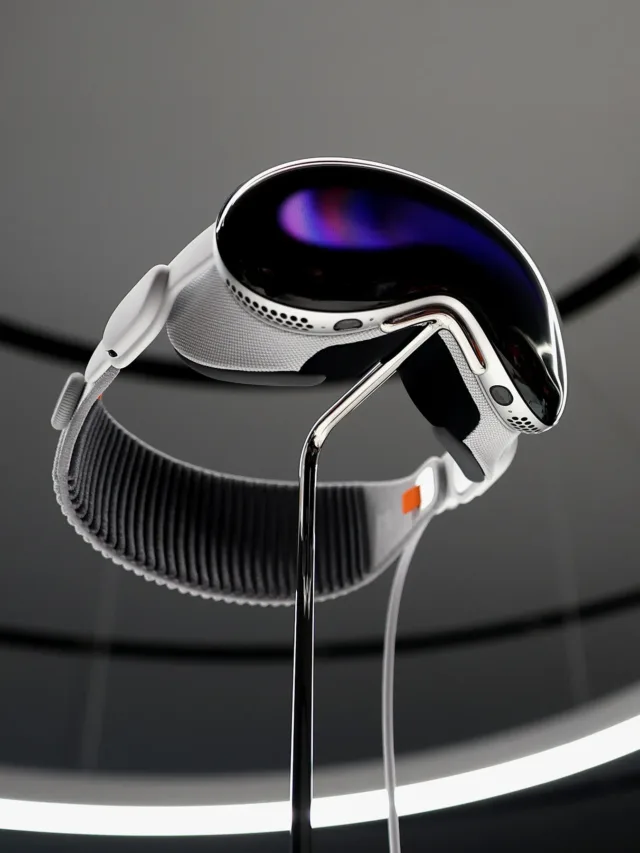Apple Vision Pro was unveiled by Apple which is its revolutionary mixed-reality headset, during the much-awaited Worldwide Developers Conference 2023. This ground-breaking tool seamlessly combines virtual reality (VR) and augmented reality (AR) technologies, representing a crucial turning point in the development of spatial computing. The Rs 2,86,600 Vision Pro offers an entirely new age of immersive experiences and limitless opportunities.
Table of Contents
Reactions from Tech Industry Leaders
Sundar Pichai, the CEO of Google and Alphabet, expressed his enthusiasm for Vision Pro and emphasized the potential of this technology. Even though Pichai claimed he had never used or seen the headset, he recognized how transformational computers are when it extends beyond conventional screens. While praising Apple’s innovative product, Meta’s CEO Mark Zuckerberg emphasized the different strategies used by each company. These replies highlight the relevance and influence of Apple’s most recent venture into spatial computing.

The Spatial Computer Unveiled: Features and Functions
The Apple Vision Pro is an example of a new category of technology known as “spatial computers.” In contrast to conventional computers, this headset projects digital content onto tiny, high-resolution monitors that are placed in front of the user’s eyes. Physical screens are not required because eye tracking and gestures serve as the main user interface. The gadget offers a flexible canvas that may be used to show digital outputs in any physical place. Users now have access to a liberating, adaptable, and immersive computing experience thanks to this innovation.
The Potential of Virtual and Augmented Reality
Apple purposely does not refer to the Vision Pro as an augmented reality (AR) or virtual reality (VR) device, despite the fact that it has the technological ability to support these technologies. Instead, the system seeks to be a spatial computer that supports the use of AR and VR applications. The Vision Pro uses augmented reality to enhance the user’s environment by supplying pertinent information and improving perception. However, virtual reality (VR) immerses people in computer-generated settings, opening up fresh opportunities for experiences, simulations, and learning.

Utilizing AR and VR to Increase Productivity
Applications that boost productivity and decision-making effectiveness are where spatial computing truly shines. These applications can give users contextual information and enhance their decision-making abilities by utilizing the potential of AR and VR. The Vision Pro opens doors for sectors including aviation, construction, and healthcare, from realistic simulations for training reasons to complicated design development. The potential of Apple’s spatial computer can be used by developers to innovate and build new applications.
The Control Interface: Eyes and Gestures
With the release of the Vision Pro, Apple altered the control interface. While some control is possible with hand motions and depth sensors, eye tracking is still the main input method. Users are able to interact with the headset through their gaze thanks to the device’s integrated camera array, which precisely recognizes eye movement. The Vision Pro may serve as a model for future sophisticated brain-computer interfaces thanks to these developments in control interface, which enable a more natural and seamless user experience.

The Path to Brain-Computer Interfaces (BCI)
Apple’s patents for the Vision Pro reveal the company’s exploration of non-invasive brain-computer interfaces.
Vision Pro: A Pioneer in Non-Invasive BCI Technology
The company’s dedication to developing brain-computer interface (BCI) technology is demonstrated by Apple’s Vision Pro. While Apple’s considerable research and patents suggest that non-invasive BCI may be incorporated in future iterations, the current iteration of the headset relies on eye tracking and gestures for control. With the help of this ground-breaking technology, people with disabilities would have a whole new range of options, and the way humans and computers interact would be completely transformed.
By using sensors instead of invasive treatments, non-invasive BCI technology can detect and decipher brain activity. The Vision Pro might understand these signals and convert them into useful commands or actions using cutting-edge algorithms and machine learning methods. This has the power to alter how we connect with technology, communicate, and move around online.

The Vision Pro is a pioneer in this field thanks to Apple’s dedication to research and development in this area, even though the incorporation of non-invasive BCI technology in consumer devices is still in its infancy. Due to the company’s emphasis on customer privacy and data security, any BCI deployment will follow high ethical standards and protect user information.
Apple has bigger plans for spatial computing than just the Vision Pro headset. Apple wants to make computing smooth and user-friendly by fusing spatial computing, augmented reality, virtual reality, and the possibilities of BCI technology. The combination of these technologies has the power to fundamentally alter how we experience and engage with the digital world, making it more open, immersive, and individualized.
Finally, Apple’s Vision Pro is a significant step toward the future of spatial computing. Apple is expanding the possibilities for human-computer interaction by seamlessly fusing augmented and virtual reality, reinventing control interfaces, and investigating the potential of non-invasive BCI technologies. We can look forward to a new era of computer experiences that are more immersive, effective, and inclusive as the Vision Pro develops and developers take advantage of its potential.
Disclaimer:
AI was used to conduct research and help write parts of the article. We primarily use the Gemini model developed by Google AI. While AI-assisted in creating this content, it was reviewed and edited by a human editor to ensure accuracy, clarity, and adherence to Google's webmaster guidelines.



